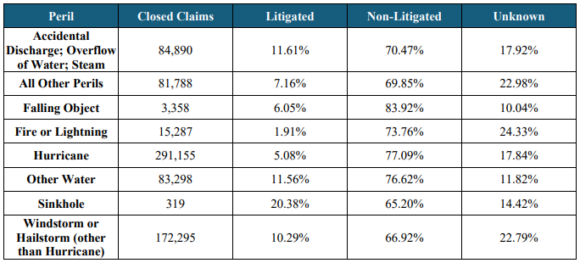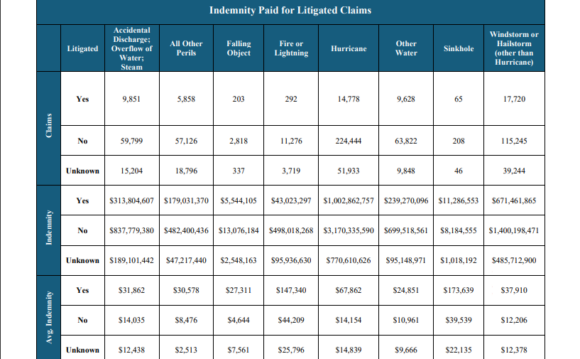Stakeholders have continued to react to a recent Florida Office of Insurance Regulation report on the property insurance market, a report that underscored the impact that excessive claims litigation had on insurers but which also noted that some key data was not available.
“I was struck by the fact that OIR is still not getting all the data that’s required by Senate Bill 76,” a bill approved by Florida lawmakers in 2021, said Kevin Comerer, a consultant with Turnbull & Associates, a lobbying group that represents a number of insurance carriers.
The 10-page OIR analysis, titled the Florida Property Claims and Litigation Report, noted that 621 U.S. companies had been notified of the data call on 2022 claims litigation, but only 180 submitted information. It did not explain why more carriers did not participate or which ones did. At a 2022 OIR workshop, insurance representatives argued that SB 76 and OIR were asking for information that insurers aren’t privy to. That includes the dollar amount of plaintiff’s attorney fees on each claim, which is not often made available. And the electronic OIR form left no clear alternative if the amount was unknown.
That may have prompted some insurers to eschew participating in the data-gathering effort. The OIR fined 13 carriers a total of $38,000 for missing deadlines, Insurance Commissioner Michael Yaworsky said in recent news reports.
Still, the information gleaned from those carriers that did participate gives some insight into how severely litigation had impacted the Florida market before the heralded 2023 legislative reforms took effect.
The study “clearly demonstrates litigation has been an outsized problem in the state,” said Logan McFaddin, vice president of state government relations for the American Property Casualty Insurance Association.
While some in the plaintiffs’ bar have argued recently that litigation was not the bugaboo that the Florida insurance has claimed it was, the report says otherwise.
“The report also shows that in 2022, more than 58,000 property claims were litigated in Florida. Other states typically have only hundreds of such cases annually,” McFaddin said.
A statistic that has often been cited by Florida insurers about Florida’s disproportionate share of lawsuits also seems to have improved, even before the 2023 reform laws had an impact. The OIR said that Florida in 2022 accounted for almost 15% of claims filed nationwide, but almost 71% of the claims litigation in the country. That’s an improvement over the 8%-to-79% ratio that was reported for 2021, based on data from OIR and the National Association of Insurance Commissioners.
Other highlights from the report:
- The total number of reported claims in 2022 was 732,390. Of those, some 58,000 were litigated.
- The total cost of indemnity paid for closed claims in 2022 was $11.2 billion.
The analysis also shows how costly litigation can be for insurers, even without policyholder attorney fees factored in:
- For litigated claims, the average indemnity paid for all types of claims was $67,636 – almost four times the average indemnity for non-litigated claims.
- The average loss adjustment expense for litigated claims for all types of perils was $9,934, compared to $1,576 for non-litigated claims.
While insurance industry advocates have long complained about the attorney-fee multipliers built into Florida statutes and case law before the 2023 reforms, the report suggests that multipliers weren’t much of a cost factor in 2022:
- Of the 58,395 litigated claims in 2022, almost half reported no fee multipliers.
- Only a handful of claims had multipliers of more than 1.5, although some 36,500 claims reported that the multiplier was unknown.
For all perils, the average time it took to close a claim in 2022 was 60 days.
Other data points raised questions about about the reason for some of the claims lawsuits. The Miami Herald noted last week that disproportionately high percentage of claims litigation came from south Florida, which suggests fraudulent or abusive litigation practices by claimants. Some 31% of claims in Miami-Dade County, for example, were litigated. That was the highest percentage in the state, the OIR report shows.
The full OIR report can be seen here.
Charts: From the OIR report.
Was this article valuable?
Here are more articles you may enjoy.




 It’s Beginning to Look Like Another Record for Holiday Travel
It’s Beginning to Look Like Another Record for Holiday Travel  New York Considers Making Property Insurers Cover Taxi Claims Losses
New York Considers Making Property Insurers Cover Taxi Claims Losses  AccuWeather’s 2024 White Christmas Forecast Calls for Snow in More Areas
AccuWeather’s 2024 White Christmas Forecast Calls for Snow in More Areas  European Central Bank Pitches Plan to Boost Coverage for Climate Losses
European Central Bank Pitches Plan to Boost Coverage for Climate Losses 